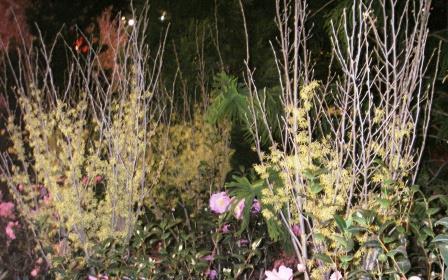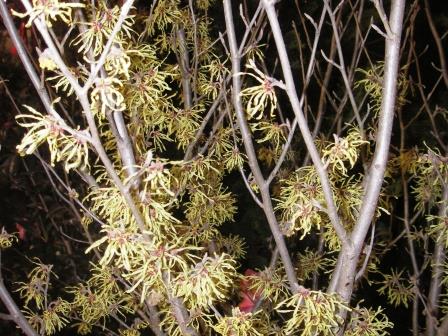 This time of year, gardeners are filled with longing for green, but we’ll settle for even a glimpse of growing. We search for the tiniest hint that spring is on the way. If you are impatient, as I am, consider planting a native herb that is an early herald of spring, Hamamelis virginiana, or witch hazel. The famous garden writer, Vita Sackville-West described it thus:
This time of year, gardeners are filled with longing for green, but we’ll settle for even a glimpse of growing. We search for the tiniest hint that spring is on the way. If you are impatient, as I am, consider planting a native herb that is an early herald of spring, Hamamelis virginiana, or witch hazel. The famous garden writer, Vita Sackville-West described it thus:
“And the Witch-hazel, Hamamelis mollis,
That comes before its leaf on naked bough,
Torn ribbons frayed, of yellow and maroon
And sharp of scent in frosty English air.”
The Hamamelis mollis of which she speaks is the Chinese witch hazel, brought to England in 1879. It quickly became a popular plant for its fragrant, very early bloom. One of its folk names is “winter bloom.” In the photo at the top, the blooming shrubs on the left and right sides are witch hazels displaying their pale yellow ribbons. Before you wonder, no it’s not my garden, but photos I took one year at the fabulous Philadelphia Flower Show.
Do not be hesitant to include this plant in your garden, wary of the term “witch” because it has nothing to do with wicked, warted crones. In olden days, inexpensive fencing was accomplished by growing dense shrubs and weaving the branches (wyches) together to enclose livestock and keep out intruders. When colonists came to the New World, the growth of the Hamamelis reminded them of that form, which led to its name.
However, if you prefer to think it more magical or related to witches, there are some who thought the plant must have unusual powers because of its seed capsules having the uncanny ability to shoot seeds over twenty feet in mid-autumn. Forked witch hazel branches have also been the traditional choice to use as divining rods or “witching rods” to locate underground water, sometimes called “witching for water.”
 The fragrant, ribbony-yellow blooms of witch hazel are some of the earliest to appear, especially if given a sheltered easterly exposure. It can tolerate light shade, and in fact prefers it in drier locations. Ideally it loves a loamy, well-draining soil, neutral to lightly acidic and grows happily in Zones 4-8 (some say 3-9.) Since I have heavy clay, which they don’t fancy, I’ll definitely have to work on soil improvement before planting. The large toothed leaves provide a dappled shade in summer and turn brilliant yellow in autumn. Take care in making a selection for growing, because not all witch hazels are hardy in all zones. Also, some bloom in autumn rather than in late winter, and some have the unfortunate characteristic to bloom while still holding their leaves, which obscures the flowering.
The fragrant, ribbony-yellow blooms of witch hazel are some of the earliest to appear, especially if given a sheltered easterly exposure. It can tolerate light shade, and in fact prefers it in drier locations. Ideally it loves a loamy, well-draining soil, neutral to lightly acidic and grows happily in Zones 4-8 (some say 3-9.) Since I have heavy clay, which they don’t fancy, I’ll definitely have to work on soil improvement before planting. The large toothed leaves provide a dappled shade in summer and turn brilliant yellow in autumn. Take care in making a selection for growing, because not all witch hazels are hardy in all zones. Also, some bloom in autumn rather than in late winter, and some have the unfortunate characteristic to bloom while still holding their leaves, which obscures the flowering.
The Chicago Botanic Garden is currently trialing dozens of varieties of witch hazels and invites the public to come see the show these plants put on in February. The plants are in their second year. They will also publish their evaluations on their website, so you can benefit from their data and observations. After their first year analysis, I’m considering “Little Suzie,” “Arnold Promise,” “Sunburst,” and “Sandra” but “Jelena” and “Pallida” might also be in the running, depending upon their performance this year.
An astringent lotion distilled from witch hazel’s bark, twigs and leaves has long been used to soften skin, relieve insect bites, treat varicose veins, bruises and swelling. It makes an excellent alcohol-free skin cleanser and after shave. Leaves can be steeped in boiling water, which is strained used as a foot bath to ease sore feet.
Witch hazel is a relative of the sweet gum tree, and fothergilla shrubs. It is the birthday flower for August 9th, symbolizing changeability, consolation, inspiration and enchantment.
I’ll be searching for various varieties of witch hazels to add to my gardens in the coming months. The internet shows colors ranging from nearly white through yellows and oranges to deep maroon, achieved in many cases by crossing H. mollis and H. virginiana. Hopefully, next winter I’ll have some fragrant ribbon blooms to enjoy.

The Chicago Botanical Garden has a wonderful collection!
LikeLike
By coincidence just been admiring magnificent specimens in Bodnant (UK). Together with Daphne and ? winter honeysuckle the perfume was fabulous..
LikeLike
Probably need this. Good for the med cabinet.
LikeLike
Nice to read about winter flowering plants at this dreary time of year. I’ve also been thinking about things that bloom during the short, dark days of winter in our northern climes…have come up with a few including the pretty winter flowering viburnum with its sweet scented clusters of tiny pink blossom that continue to bloom in my garden through frost, snow, ice and rain. Love to have a little bouquet of these on the Christmas dinner table. I will have to keep an eye open for your “good witch” to add to my collection. Thank you for the interesting post.
LikeLike
Something I’ve thought about over the years. Keep us posted on what you choose.
Where do you live that you contend with clay soil. I’m on the Eastern Shore of the Chesapeake Bay and sometimes it’s like gardening in a bathtub with no drain hole.
LikeLike
We’re in north central Indiana. If you can dig a hole here you are lucky, which is why I’m loving my new raised beds for the potager.
LikeLike
Raised beds is the only way I can grow root veggies.
LikeLike
I planted ‘Jelena’ some years ago and it is stunning! Spring bloomer. Or was, because 2 years ago at Thanksgiving, I was on crutches and looking out the back window. What was that on my witch hazel? I sent someone out with my camera, and lo and behold, it was all abloom with yellow (not orange/yellow) flowers. At Thanksgiving. ‘Jelena’ is gone, doubtless a victim of my inattention and her root source’s aggressiveness. Nonetheless, I have a lovely Hamamelis virginiana now. So I guess… watch out for suckers!!
LikeLike
Good to know! None of the sources I’ve been reading mentioned that possibility!
LikeLike
I have a native witch hazel in my yard. Purchased it over 20 years ago, it has kind of a sprawling habit and I have had to cut it back, but it really cheers me up when it blooms-usually in March- tends to be the month of mud around here in Massachusetts. Purchased it a Weston Nurseries in Hopkinton, MA, they have a great selection of native plants.
LikeLike
Isn’t is lovely when a nursery recognizes the benefits and carries a good selection of native plants? I’m glad to see plant breeders working with them more, too.
LikeLiked by 1 person
I’d love to grow this but it hates my limey soil. Lots of things do, it’s a real pain.
LikeLike
Ohh! Limey soil. Bet you grow lovely lavenders!
LikeLike
Yup, and clematis and cyclamen and peonies. Could grow acid lovers in pots but prefer not to fight nature, but still get jealous of neutral ph gardeners!
LikeLiked by 1 person
I think I am going to need some of this for my garden!
LikeLike
Indeed you do! I’ve been drinking elderflower tea the past couple of days to ward off the many bugs that are going around that seem to be just on the verge of “getting me!”
LikeLike
How delicious! I have not had that either. Only the cordial. 😊
LikeLiked by 1 person